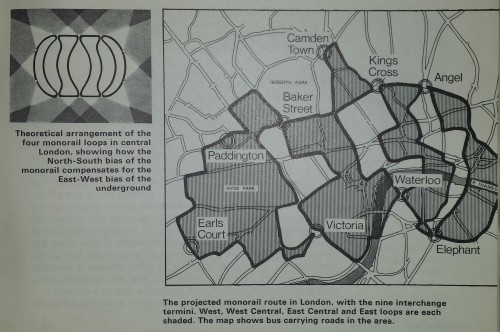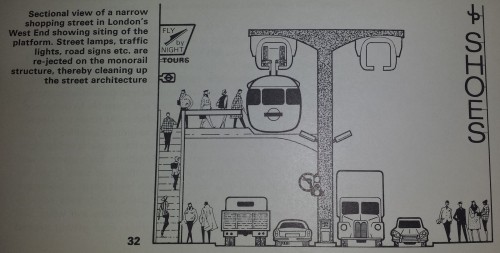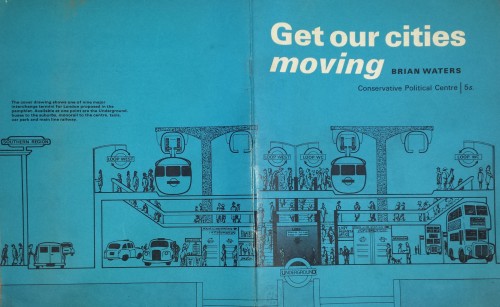In 1967, the Conservative Party published a document calling for the scrapping of buses in central London – and replacing them with a huge Monorail network.
The move was far fetched, but based on some very real concerns. Since the early 1950s, bus usage had declined as commuters switched to the motor car, and this was causing congestion problems in the centre of London.
As the report noted, London needed a better bus network, but also more space for motorists. Save some schemes to put a motorway through the middle of London, realistically, there was no more road to provide, and yet congestion continued to increase.
The scheme proposed by Brian Waters, and endorsed by Desmond Plummer, Leader of the Conservative Opposition at the GLC, was to get rid of buses entirely.
This would free up considerable road space for motorists — but what to do with the displaced public transport users?
Elevate!
A series of Monorails was planned which would have run above the streets of London, in four loops that interconnected with each other.
In a way, this was a precursor to the Docklands Light Railway, but being a monorail meant that far less rail infrastructure would be above the heads of pedestrians so that pavements wouldn’t feel gloomy.
The proposals called for the use of the electric SAFEGE system, with short trains running at around 40mph on rubber wheels — fast enough to be convenient, and quiet enough to avoid steel-on-steel screeches.
As with the Underground, passengers would use escalators to get up to the platforms, which were expected to be built alongside shops, who were then likely to be keen on opening 1st floor entrances to their stores.
Again, mirroring the later DLR, each platform would have been around 100 feet long, for 2 or 3 carriage monorail trains, and as we now have on the Jubilee line, there would have been platform edge doors to stop people falling down to the road below.
The monorail was expected to be driverless, and thus able to feed extra trains into the network when unexpected demand required it.
In terms of the monorail supports, these upright columns were to be spaced at 100 metre intervals, and with a width no wider than a current traffic island should not have been an impediment to road traffic.
It was expected that construction would take about 2 years for each of the four loops, which amounted to 43 miles of monorail network.
The cost was put at £53 million (vs the £65 million Victoria Line being built at the time). A future expansion to the Barbican was also envisioned.
Rather delightfully, the report said that if built, then “Bus diesel fumes and noise, so much a part of the London street scene, will be replaced by the gentle ‘woosh’ of the monorail passing over the street”.
Sadly, the gentle wooshing was not to come into being. Although the Conservative’s won the election later that year, their majority shrank in the following years, and the necessary political will, even if funds were available, faded away.
Today we still use buses, in volumes that can be scarce imagined — they carry twice as many passengers per day than the London Underground.
How much more interesting would London have been with a network of monorails?
Source:
Get our cities moving, Brian Waters, Conservative Political Centre
Addendum: Brian Waters is still active in town planning, and in 2013 proposed extending Crossrail to Stanstead, creating a direct rail link with Heathrow.










This would have been very quaint to have. In many ways it was a shame it didn’t happen, but on the other hand, monorails don’t have a good track record of success around the world.
OTOH 40mph sounds like a dream compared to current bus speeds in central London.
I don’t think they properly considered the amount of street furniture that the monorail access would have added – two staircases (each end of platform) plus a lift. That would have severely reduced pavement space.
A modern scheme would presumably be able to make use of modern materials – the platform could be opaque glass, to allow light through. Maybe support pillars could be even further apart. Maybe it could be a giant dangleway loop…
It looks as if the monorail was to be confined to a central area. What was intended for the outer surburbs? If built, I think this scheme would have been outmoded within a relatively short time.
“Were you sent here by the Devil?”
“No, good sirs, I’m on the level.
Monorail! Monorail! Monorail!”
Why describe as far fetched?
They managed it in Wuppertal in 1901.
https://en.wikipedia.org/wiki/Wuppertal_Suspension_Railway
I’m glad this didn’t come to fruition. Monorails, although not as cluttering as elevated railways, still have a substantial amount of street infrastructure and do block out light and ‘box in’ existing roads. Even the short Seattle monorail is a bit of an eyesore and the rails aren’t the prettiest of structures. I’m not in favour of any infrastructure that cuts out street-level light.
Cannot say whether this Central London Monorail network would have been a good thing or not, also doubt it would have completely replaced buses.
If the latter scenario is indeed the case, have to wonder how the monorail stops would interchange with the remaining bus stops.
Would have been worth seeing how the 3-car monorail network ends up being modernized, along with what other routes / loops the network would have expanded to beyond the proposed Barbican extension.
Even the Circle line no longer circles due to operating difficulties of endless routes! I remember removal of trolleybus overhead poles and wires really made a difference, brightening up Camden High Road! Monorails would have really closed things in.
And what about privacy issues? Imagine throwing those curtains wide in your first-floor flat on a monorail route and being confronted by a trainload of onlookers as you had a good scratch welcoming in the day!
A problem that presumably bedeveils people living next to bus routes with double-decker buses to this day.